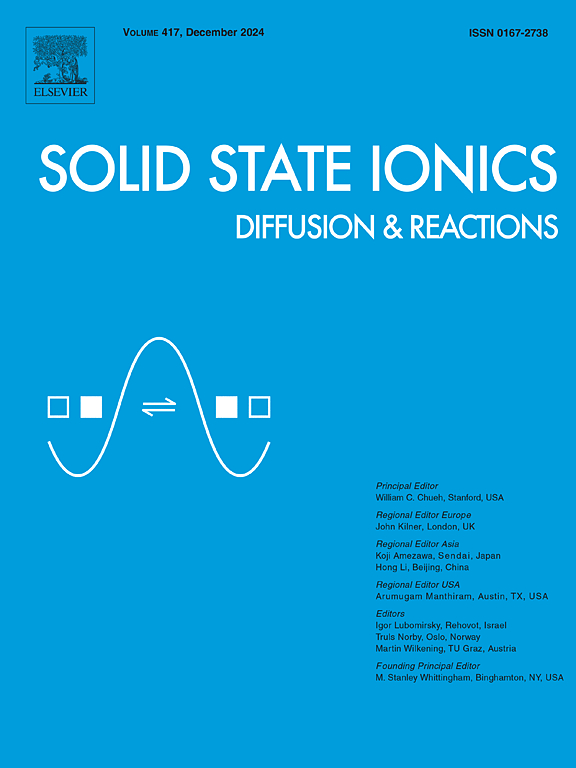利用阻抗光谱定量测定离子导体晶界的电荷捕获量
IF 3.3
4区 材料科学
Q3 CHEMISTRY, PHYSICAL
引用次数: 0
摘要
我们提出了一种确定多晶固态离子导体晶界空间电荷密度的方法。该方法是早先提出的线性扩散模型(LDM)的扩展,它依赖于从阻抗谱得到的晶界电流-电压特性。我们展示了扩展 LDM 版本的实用性,它成功地以无损方式获得了掺杂 Sr 的 LaGaO3、掺杂 Y 的 CeO2 和掺杂 Gd 的 CeO2 等多种氧离子导体以及掺杂 Sr 的 LaNbO3 和掺杂 Y 的 BaZrO3 等质子导体中晶界处捕获的空间电荷密度值。在所有情况下,晶界捕获的空间电荷密度均为 0.2C/m2,相当于每个单位晶胞的电子电荷分数。所提出的技术虽然无法确定远小于德拜长度的晶界核心厚度,但可以用来区分空间电荷和绝缘层对晶界电阻的贡献。本文章由计算机程序翻译,如有差异,请以英文原文为准。
Quantitative determination of charge trapped at grain boundaries in ionic conductors by impedance spectroscopy
We propose a method for determining the density of space charge trapped at grain boundaries in polycrystalline solid state ionic conductors. The method is an extension of the earlier proposed Linear Diffusion Model (LDM) that relies on the impedance spectra-derived current-voltage characteristics of grain boundaries. The utility of the extended LDM version is demonstrated to successfully and nondestructively obtain values for the space charge density trapped at the grain boundaries in a variety of oxygen ion conductors including Sr-doped LaGaO3, Y-doped CeO2, and Gd-doped CeO2, and proton conductors including Sr-doped LaNbO3 and Y-doped BaZrO3. For all cases, the density of the space charge trapped at the grain boundaries was <0.2C/m2, corresponding to a fraction of electron charge per unit cell. The proposed technique, while it lacks the ability to determine the thickness of the grain boundary core when much smaller than the Debye length, it can be used to distinguish between space charge vs insulating layer contributions to the grain boundary resistance.
求助全文
通过发布文献求助,成功后即可免费获取论文全文。
去求助
来源期刊

Solid State Ionics
物理-物理:凝聚态物理
CiteScore
6.10
自引率
3.10%
发文量
152
审稿时长
58 days
期刊介绍:
This interdisciplinary journal is devoted to the physics, chemistry and materials science of diffusion, mass transport, and reactivity of solids. The major part of each issue is devoted to articles on:
(i) physics and chemistry of defects in solids;
(ii) reactions in and on solids, e.g. intercalation, corrosion, oxidation, sintering;
(iii) ion transport measurements, mechanisms and theory;
(iv) solid state electrochemistry;
(v) ionically-electronically mixed conducting solids.
Related technological applications are also included, provided their characteristics are interpreted in terms of the basic solid state properties.
Review papers and relevant symposium proceedings are welcome.
 求助内容:
求助内容: 应助结果提醒方式:
应助结果提醒方式:


